Addressing Child Labour: Economic, Social, and Legal Challenges Report
VerifiedAdded on 2022/11/30
|6
|1608
|99
Report
AI Summary
This report provides a comprehensive analysis of child labour, examining its various aspects and impacts. It explores the circumstances under which working might be beneficial for children, while also investigating the role of child labour in poverty and its long-term effects on families. The report further analyzes how increasing trade openness complicates the tracing and monitoring of child labour within complex global supply chains, identifying the key stakeholders responsible and the challenges associated with banning child labour. Potential solutions to resolve the issue, such as improved hiring practices, hazardous work analysis, reduced working hours, and adherence to government policies, are also proposed. The report concludes by emphasizing the importance of addressing child labour to protect children's rights and foster economic growth.
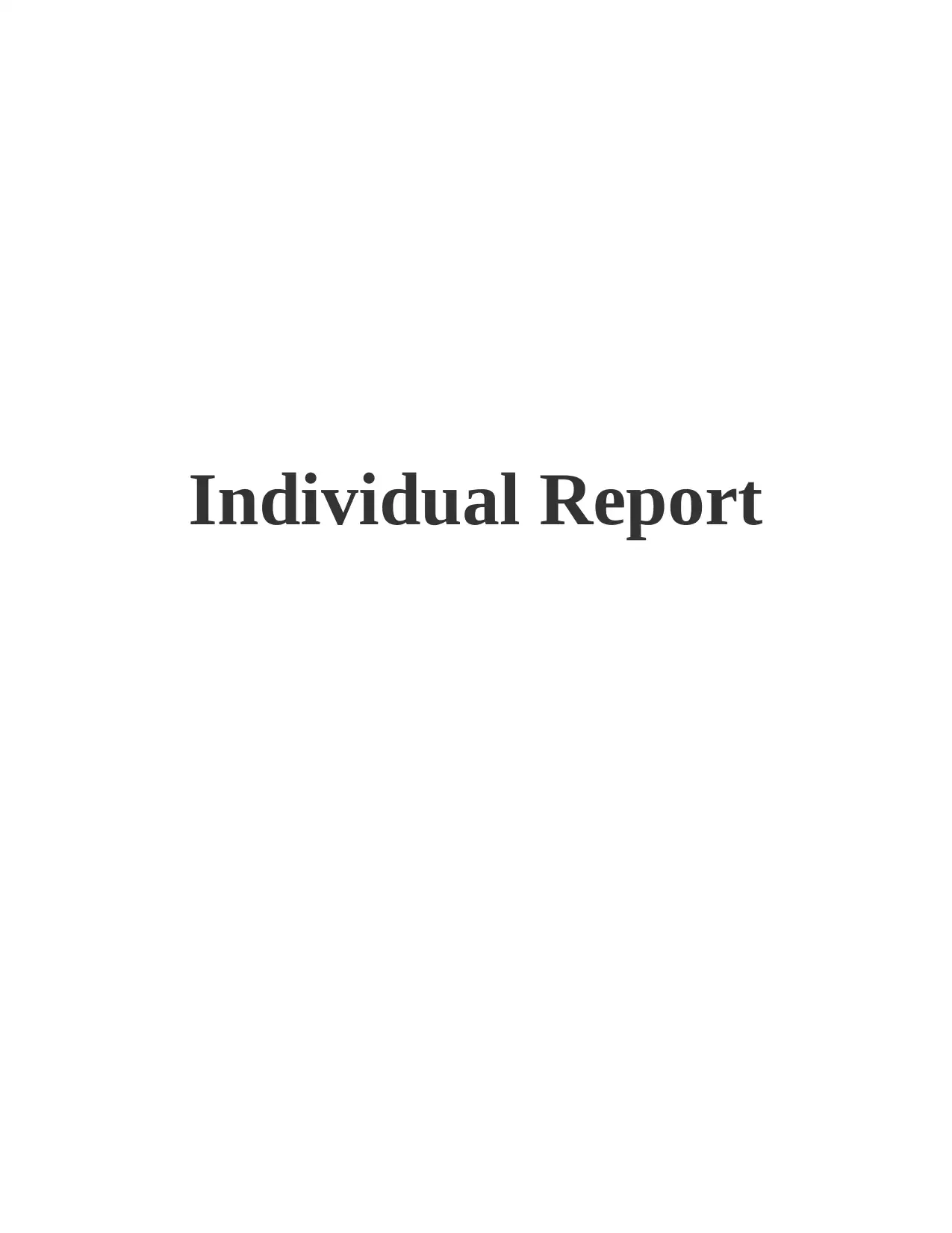
Individual Report
Paraphrase This Document
Need a fresh take? Get an instant paraphrase of this document with our AI Paraphraser
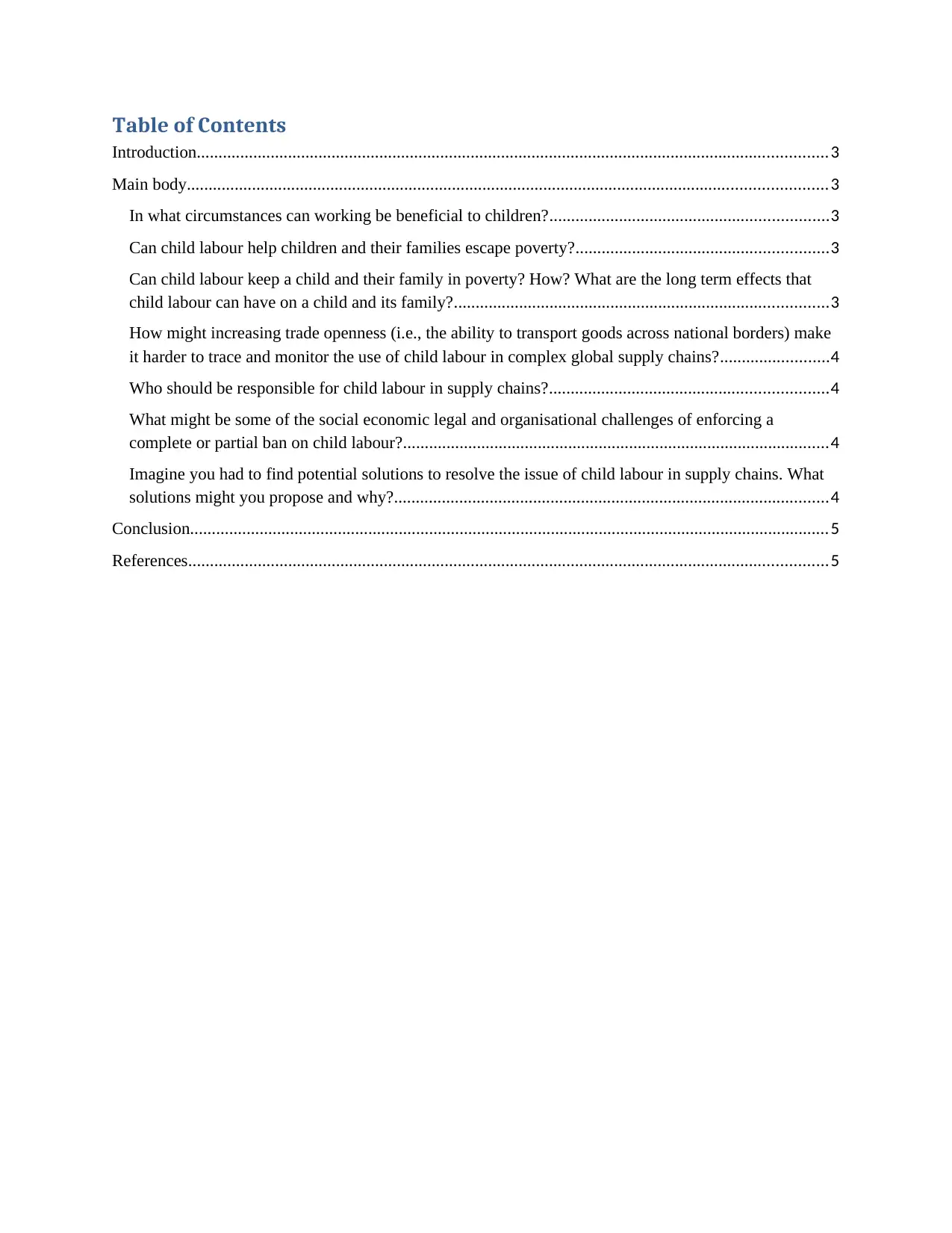
Table of Contents
Introduction.................................................................................................................................................3
Main body...................................................................................................................................................3
In what circumstances can working be beneficial to children?................................................................3
Can child labour help children and their families escape poverty?..........................................................3
Can child labour keep a child and their family in poverty? How? What are the long term effects that
child labour can have on a child and its family?......................................................................................3
How might increasing trade openness (i.e., the ability to transport goods across national borders) make
it harder to trace and monitor the use of child labour in complex global supply chains?.........................4
Who should be responsible for child labour in supply chains?................................................................4
What might be some of the social economic legal and organisational challenges of enforcing a
complete or partial ban on child labour?..................................................................................................4
Imagine you had to find potential solutions to resolve the issue of child labour in supply chains. What
solutions might you propose and why?....................................................................................................4
Conclusion...................................................................................................................................................5
References...................................................................................................................................................5
Introduction.................................................................................................................................................3
Main body...................................................................................................................................................3
In what circumstances can working be beneficial to children?................................................................3
Can child labour help children and their families escape poverty?..........................................................3
Can child labour keep a child and their family in poverty? How? What are the long term effects that
child labour can have on a child and its family?......................................................................................3
How might increasing trade openness (i.e., the ability to transport goods across national borders) make
it harder to trace and monitor the use of child labour in complex global supply chains?.........................4
Who should be responsible for child labour in supply chains?................................................................4
What might be some of the social economic legal and organisational challenges of enforcing a
complete or partial ban on child labour?..................................................................................................4
Imagine you had to find potential solutions to resolve the issue of child labour in supply chains. What
solutions might you propose and why?....................................................................................................4
Conclusion...................................................................................................................................................5
References...................................................................................................................................................5
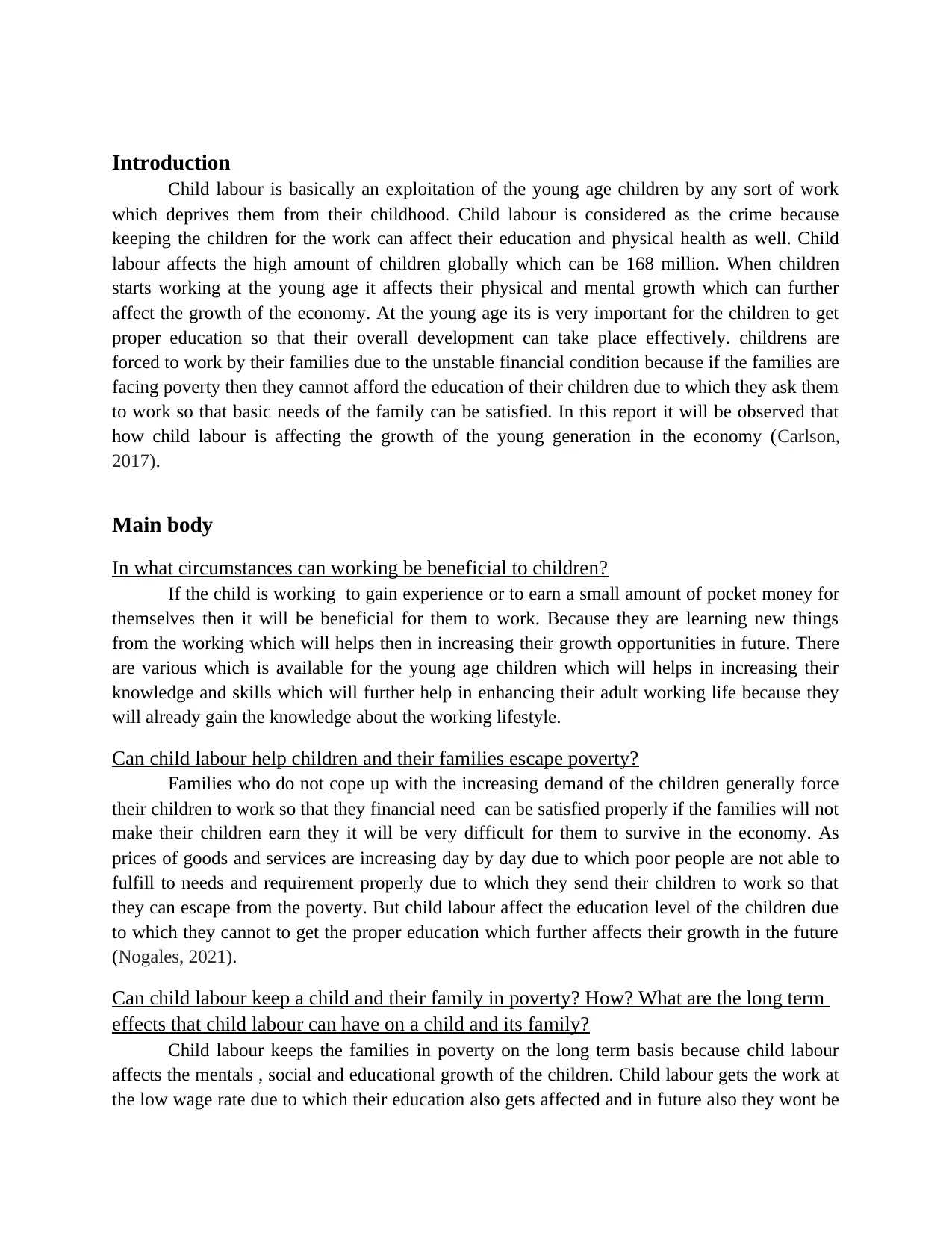
Introduction
Child labour is basically an exploitation of the young age children by any sort of work
which deprives them from their childhood. Child labour is considered as the crime because
keeping the children for the work can affect their education and physical health as well. Child
labour affects the high amount of children globally which can be 168 million. When children
starts working at the young age it affects their physical and mental growth which can further
affect the growth of the economy. At the young age its is very important for the children to get
proper education so that their overall development can take place effectively. childrens are
forced to work by their families due to the unstable financial condition because if the families are
facing poverty then they cannot afford the education of their children due to which they ask them
to work so that basic needs of the family can be satisfied. In this report it will be observed that
how child labour is affecting the growth of the young generation in the economy (Carlson,
2017).
Main body
In what circumstances can working be beneficial to children?
If the child is working to gain experience or to earn a small amount of pocket money for
themselves then it will be beneficial for them to work. Because they are learning new things
from the working which will helps then in increasing their growth opportunities in future. There
are various which is available for the young age children which will helps in increasing their
knowledge and skills which will further help in enhancing their adult working life because they
will already gain the knowledge about the working lifestyle.
Can child labour help children and their families escape poverty?
Families who do not cope up with the increasing demand of the children generally force
their children to work so that they financial need can be satisfied properly if the families will not
make their children earn they it will be very difficult for them to survive in the economy. As
prices of goods and services are increasing day by day due to which poor people are not able to
fulfill to needs and requirement properly due to which they send their children to work so that
they can escape from the poverty. But child labour affect the education level of the children due
to which they cannot to get the proper education which further affects their growth in the future
(Nogales, 2021).
Can child labour keep a child and their family in poverty? How? What are the long term
effects that child labour can have on a child and its family?
Child labour keeps the families in poverty on the long term basis because child labour
affects the mentals , social and educational growth of the children. Child labour gets the work at
the low wage rate due to which their education also gets affected and in future also they wont be
Child labour is basically an exploitation of the young age children by any sort of work
which deprives them from their childhood. Child labour is considered as the crime because
keeping the children for the work can affect their education and physical health as well. Child
labour affects the high amount of children globally which can be 168 million. When children
starts working at the young age it affects their physical and mental growth which can further
affect the growth of the economy. At the young age its is very important for the children to get
proper education so that their overall development can take place effectively. childrens are
forced to work by their families due to the unstable financial condition because if the families are
facing poverty then they cannot afford the education of their children due to which they ask them
to work so that basic needs of the family can be satisfied. In this report it will be observed that
how child labour is affecting the growth of the young generation in the economy (Carlson,
2017).
Main body
In what circumstances can working be beneficial to children?
If the child is working to gain experience or to earn a small amount of pocket money for
themselves then it will be beneficial for them to work. Because they are learning new things
from the working which will helps then in increasing their growth opportunities in future. There
are various which is available for the young age children which will helps in increasing their
knowledge and skills which will further help in enhancing their adult working life because they
will already gain the knowledge about the working lifestyle.
Can child labour help children and their families escape poverty?
Families who do not cope up with the increasing demand of the children generally force
their children to work so that they financial need can be satisfied properly if the families will not
make their children earn they it will be very difficult for them to survive in the economy. As
prices of goods and services are increasing day by day due to which poor people are not able to
fulfill to needs and requirement properly due to which they send their children to work so that
they can escape from the poverty. But child labour affect the education level of the children due
to which they cannot to get the proper education which further affects their growth in the future
(Nogales, 2021).
Can child labour keep a child and their family in poverty? How? What are the long term
effects that child labour can have on a child and its family?
Child labour keeps the families in poverty on the long term basis because child labour
affects the mentals , social and educational growth of the children. Child labour gets the work at
the low wage rate due to which their education also gets affected and in future also they wont be
⊘ This is a preview!⊘
Do you want full access?
Subscribe today to unlock all pages.

Trusted by 1+ million students worldwide
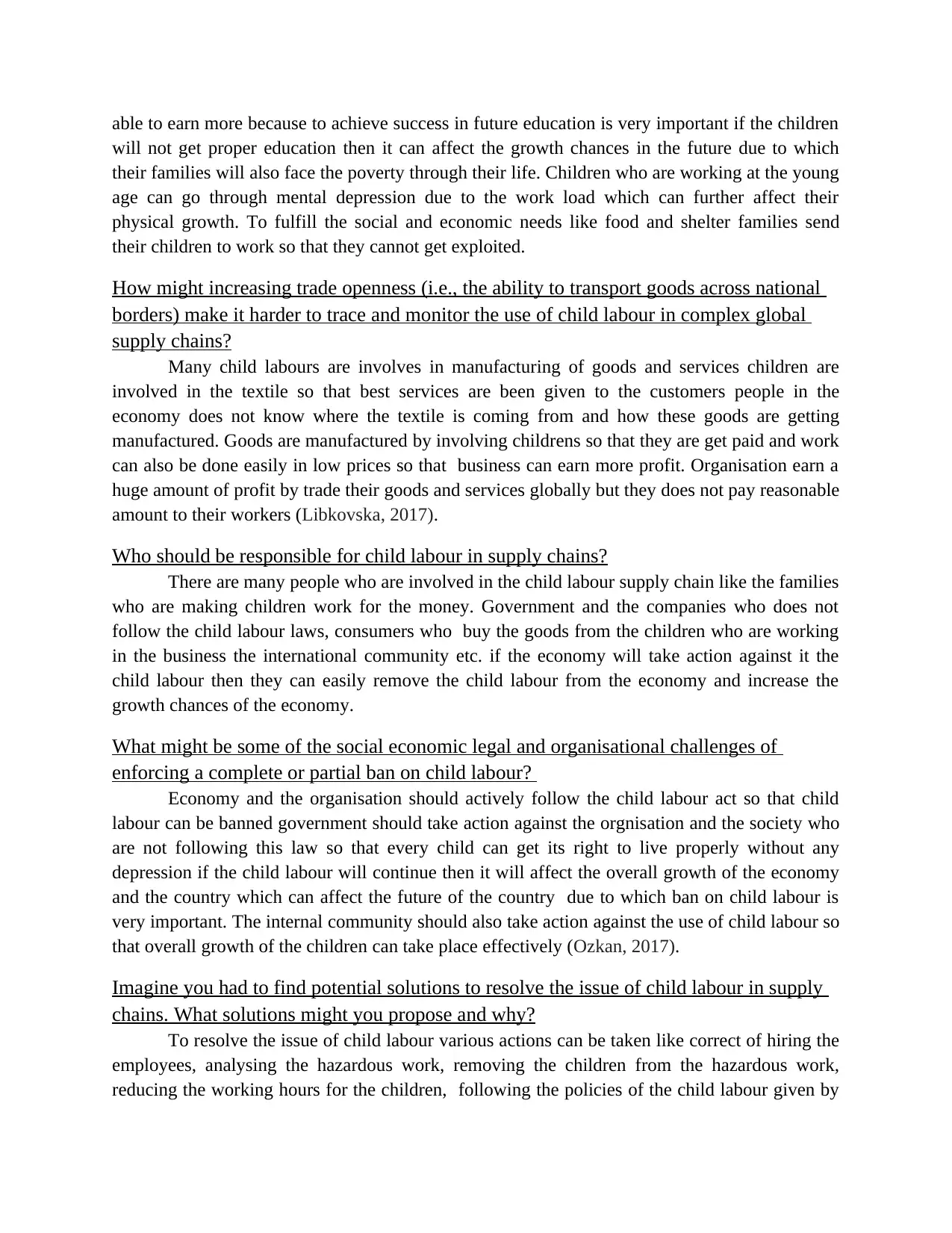
able to earn more because to achieve success in future education is very important if the children
will not get proper education then it can affect the growth chances in the future due to which
their families will also face the poverty through their life. Children who are working at the young
age can go through mental depression due to the work load which can further affect their
physical growth. To fulfill the social and economic needs like food and shelter families send
their children to work so that they cannot get exploited.
How might increasing trade openness (i.e., the ability to transport goods across national
borders) make it harder to trace and monitor the use of child labour in complex global
supply chains?
Many child labours are involves in manufacturing of goods and services children are
involved in the textile so that best services are been given to the customers people in the
economy does not know where the textile is coming from and how these goods are getting
manufactured. Goods are manufactured by involving childrens so that they are get paid and work
can also be done easily in low prices so that business can earn more profit. Organisation earn a
huge amount of profit by trade their goods and services globally but they does not pay reasonable
amount to their workers (Libkovska, 2017).
Who should be responsible for child labour in supply chains?
There are many people who are involved in the child labour supply chain like the families
who are making children work for the money. Government and the companies who does not
follow the child labour laws, consumers who buy the goods from the children who are working
in the business the international community etc. if the economy will take action against it the
child labour then they can easily remove the child labour from the economy and increase the
growth chances of the economy.
What might be some of the social economic legal and organisational challenges of
enforcing a complete or partial ban on child labour?
Economy and the organisation should actively follow the child labour act so that child
labour can be banned government should take action against the orgnisation and the society who
are not following this law so that every child can get its right to live properly without any
depression if the child labour will continue then it will affect the overall growth of the economy
and the country which can affect the future of the country due to which ban on child labour is
very important. The internal community should also take action against the use of child labour so
that overall growth of the children can take place effectively (Ozkan, 2017).
Imagine you had to find potential solutions to resolve the issue of child labour in supply
chains. What solutions might you propose and why?
To resolve the issue of child labour various actions can be taken like correct of hiring the
employees, analysing the hazardous work, removing the children from the hazardous work,
reducing the working hours for the children, following the policies of the child labour given by
will not get proper education then it can affect the growth chances in the future due to which
their families will also face the poverty through their life. Children who are working at the young
age can go through mental depression due to the work load which can further affect their
physical growth. To fulfill the social and economic needs like food and shelter families send
their children to work so that they cannot get exploited.
How might increasing trade openness (i.e., the ability to transport goods across national
borders) make it harder to trace and monitor the use of child labour in complex global
supply chains?
Many child labours are involves in manufacturing of goods and services children are
involved in the textile so that best services are been given to the customers people in the
economy does not know where the textile is coming from and how these goods are getting
manufactured. Goods are manufactured by involving childrens so that they are get paid and work
can also be done easily in low prices so that business can earn more profit. Organisation earn a
huge amount of profit by trade their goods and services globally but they does not pay reasonable
amount to their workers (Libkovska, 2017).
Who should be responsible for child labour in supply chains?
There are many people who are involved in the child labour supply chain like the families
who are making children work for the money. Government and the companies who does not
follow the child labour laws, consumers who buy the goods from the children who are working
in the business the international community etc. if the economy will take action against it the
child labour then they can easily remove the child labour from the economy and increase the
growth chances of the economy.
What might be some of the social economic legal and organisational challenges of
enforcing a complete or partial ban on child labour?
Economy and the organisation should actively follow the child labour act so that child
labour can be banned government should take action against the orgnisation and the society who
are not following this law so that every child can get its right to live properly without any
depression if the child labour will continue then it will affect the overall growth of the economy
and the country which can affect the future of the country due to which ban on child labour is
very important. The internal community should also take action against the use of child labour so
that overall growth of the children can take place effectively (Ozkan, 2017).
Imagine you had to find potential solutions to resolve the issue of child labour in supply
chains. What solutions might you propose and why?
To resolve the issue of child labour various actions can be taken like correct of hiring the
employees, analysing the hazardous work, removing the children from the hazardous work,
reducing the working hours for the children, following the policies of the child labour given by
Paraphrase This Document
Need a fresh take? Get an instant paraphrase of this document with our AI Paraphraser
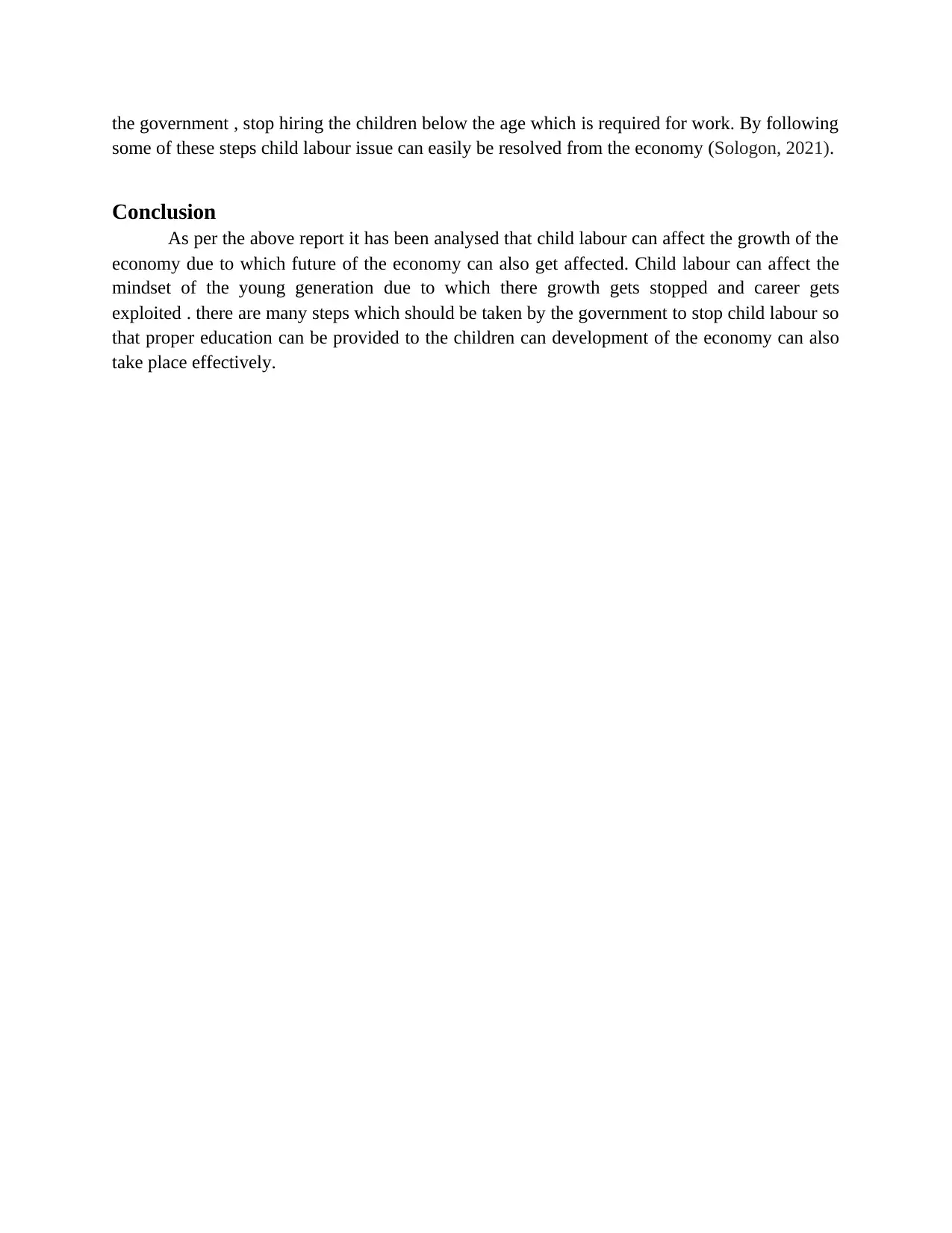
the government , stop hiring the children below the age which is required for work. By following
some of these steps child labour issue can easily be resolved from the economy (Sologon, 2021).
Conclusion
As per the above report it has been analysed that child labour can affect the growth of the
economy due to which future of the economy can also get affected. Child labour can affect the
mindset of the young generation due to which there growth gets stopped and career gets
exploited . there are many steps which should be taken by the government to stop child labour so
that proper education can be provided to the children can development of the economy can also
take place effectively.
some of these steps child labour issue can easily be resolved from the economy (Sologon, 2021).
Conclusion
As per the above report it has been analysed that child labour can affect the growth of the
economy due to which future of the economy can also get affected. Child labour can affect the
mindset of the young generation due to which there growth gets stopped and career gets
exploited . there are many steps which should be taken by the government to stop child labour so
that proper education can be provided to the children can development of the economy can also
take place effectively.
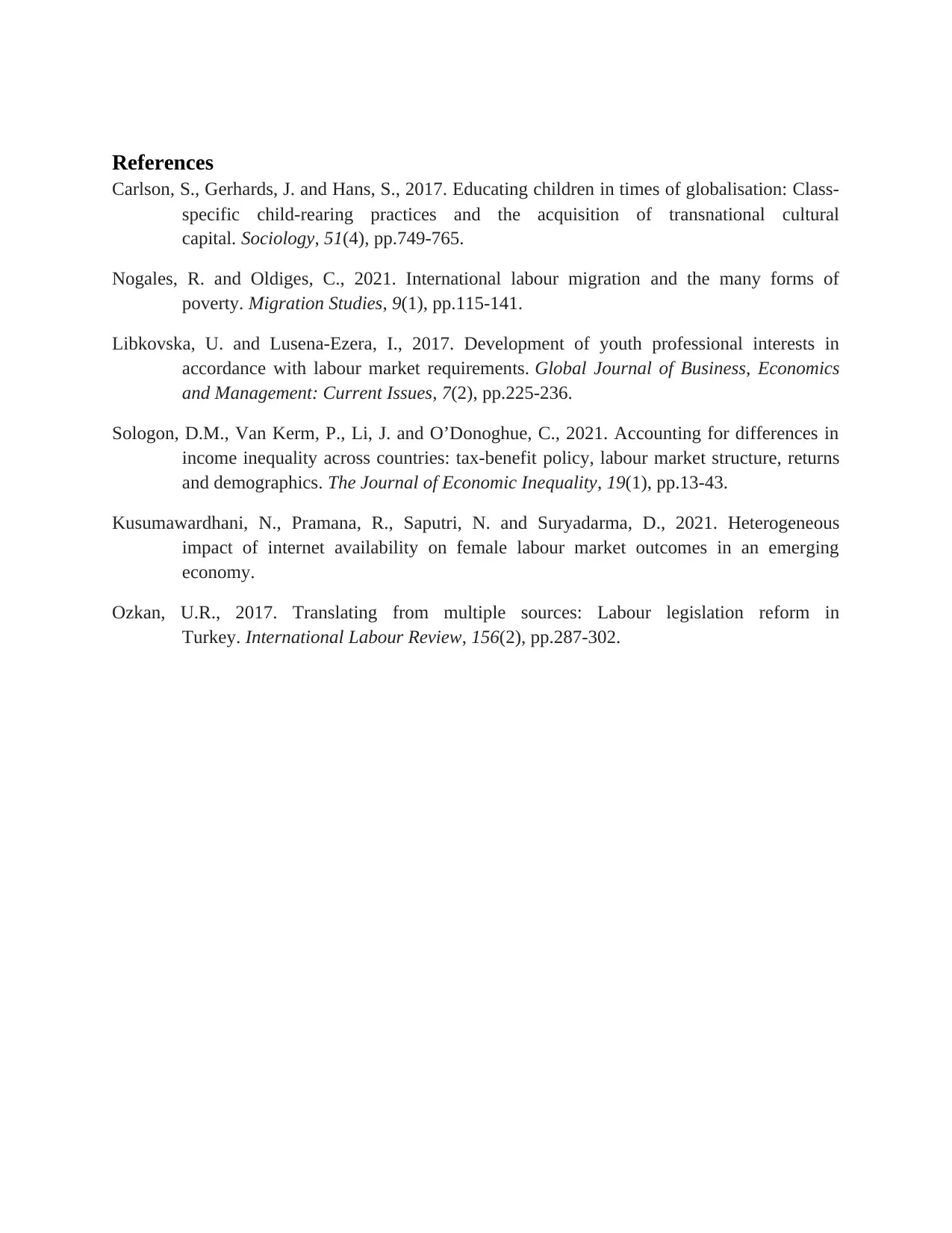
References
Carlson, S., Gerhards, J. and Hans, S., 2017. Educating children in times of globalisation: Class-
specific child-rearing practices and the acquisition of transnational cultural
capital. Sociology, 51(4), pp.749-765.
Nogales, R. and Oldiges, C., 2021. International labour migration and the many forms of
poverty. Migration Studies, 9(1), pp.115-141.
Libkovska, U. and Lusena-Ezera, I., 2017. Development of youth professional interests in
accordance with labour market requirements. Global Journal of Business, Economics
and Management: Current Issues, 7(2), pp.225-236.
Sologon, D.M., Van Kerm, P., Li, J. and O’Donoghue, C., 2021. Accounting for differences in
income inequality across countries: tax-benefit policy, labour market structure, returns
and demographics. The Journal of Economic Inequality, 19(1), pp.13-43.
Kusumawardhani, N., Pramana, R., Saputri, N. and Suryadarma, D., 2021. Heterogeneous
impact of internet availability on female labour market outcomes in an emerging
economy.
Ozkan, U.R., 2017. Translating from multiple sources: Labour legislation reform in
Turkey. International Labour Review, 156(2), pp.287-302.
Carlson, S., Gerhards, J. and Hans, S., 2017. Educating children in times of globalisation: Class-
specific child-rearing practices and the acquisition of transnational cultural
capital. Sociology, 51(4), pp.749-765.
Nogales, R. and Oldiges, C., 2021. International labour migration and the many forms of
poverty. Migration Studies, 9(1), pp.115-141.
Libkovska, U. and Lusena-Ezera, I., 2017. Development of youth professional interests in
accordance with labour market requirements. Global Journal of Business, Economics
and Management: Current Issues, 7(2), pp.225-236.
Sologon, D.M., Van Kerm, P., Li, J. and O’Donoghue, C., 2021. Accounting for differences in
income inequality across countries: tax-benefit policy, labour market structure, returns
and demographics. The Journal of Economic Inequality, 19(1), pp.13-43.
Kusumawardhani, N., Pramana, R., Saputri, N. and Suryadarma, D., 2021. Heterogeneous
impact of internet availability on female labour market outcomes in an emerging
economy.
Ozkan, U.R., 2017. Translating from multiple sources: Labour legislation reform in
Turkey. International Labour Review, 156(2), pp.287-302.
⊘ This is a preview!⊘
Do you want full access?
Subscribe today to unlock all pages.

Trusted by 1+ million students worldwide
1 out of 6
Related Documents
Your All-in-One AI-Powered Toolkit for Academic Success.
+13062052269
info@desklib.com
Available 24*7 on WhatsApp / Email
![[object Object]](/_next/static/media/star-bottom.7253800d.svg)
Unlock your academic potential
Copyright © 2020–2025 A2Z Services. All Rights Reserved. Developed and managed by ZUCOL.





